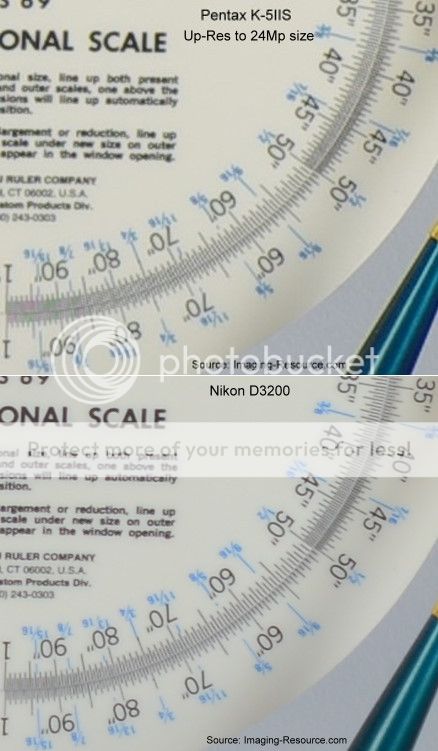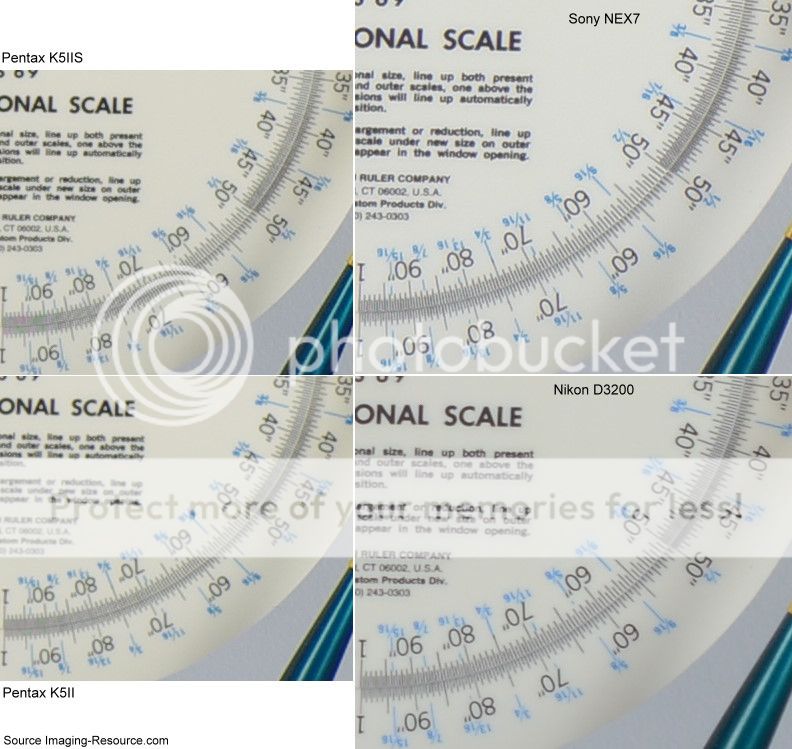Hmmmm... VT I have to say thanks for putting the work into that... having done this a few times in the last few days.. and realizing that it's not rocket science but it is tedious.. thanks for those images. To me, being able to look at your image comparisons is worth more than any description or reference to spread sheets that purport to examine the issues doesn't tell me what I need to know. Because the issue is "what will this mean to me, and to decide that I need to see the image comparisons. I need to be able to look at the K-5 images and say.."OK I can live with that."
What I was hoping to establish at this point was what is the magic number, where there would be a technical advantage to FF. The answer surprised me. I was expecting that as long as I was shooting within 4900 pixel width, the K-5 would deliver to it's full potential. I came up with a number somewhat less than that. The K-5 images need to be cropped to somewhere between 3500 and 4000 pixels before they can compete with D-800 images also cropped to 3500-4000 pixels. D800 images cropped to 4928 are clearer then K-5 images at the same resolution. And that is because the lenses available for the K-5 are can only resolve about about 70% of what the K-5 sensor is capable of resolving. SO it doesn't surprise me at all that K-5 images upsized to D800 size is not as sharp. that's what I'd expect.
So the "big" conclusion here is if you really need the best resolution at the 4928 pixels the K-5 is capable of, you're going to have to buy a D800 and reduce the size to 4928, to get it. If on the other hand if you never need your images more than 3500 to 4000 pixels (I haven't done exact enough comparisons to even guess what the exact number might be) then you can get away with using a K-5.
All the points about cropping are noted, however, being a film guy, I always frame to avoid cropping. It's a "how much can I enlarge this image" issue. Maybe sometimes in the field I make a mistake and end up wanting a different crop. I can live with that. It teaches me to be careful not to make mistakes in the field. And to zoom the lens with my eye to the viewfinder looking for a field of view I might have missed.
To the guys that say "yes but I can shoot and then crop later", I'd say, do you want to be a person who has the eye to pick good images out of not so good one's, or do you want to develop an eye for what's there and the ability to frame it correctly and capture it? One is a photographer, I'm not sure what the other guy is.
 Quote:
Quote: However, why don't we try comparing a 18 or 20MP FF image vs the k-5IIs, if we're trying to claim FF advantage - or even better, a 28+MP APS-C sensor vs the D800.
I guess you missed the thread where I pointed out that where I upscaled the K-5 image to the size of the D3200 (24 MP APS-c) image to show they were identical. The limit on IQ in APS-c is imposed by the lens, not by the sensor. What all this messing around has taught me, if I've learned anything from it, is that if I'm going FF, I'm going to a D800. Nothing else makes sense. The D800 has the same theoretical relationship to lens resolution the K-5 does. It's overkill in terms of lens resolution, but in terms of reducing moire, being ready for improvements in lens technology and getting the most out of existing lenses, it's right where it needs to be.
Its crazy but, if you like the K-5, you should also like the d800 as the next format going up the scale. The Pentax 645, unlike the the D800 and K-5 is not at the theoretical max of it's sensor capacity. That would be 70 MP. So even though the format is capable or more the 645 is just marginally better than the D800 in IQ. If the K-5 and D800 have taught us anything, its that there are benefits to exceeding the practical limits of the resolving power of the lens. What the D3200 has taught us is that there is no benefit to exceeding the theoretical limits of the sensor (using current technology). Right now the D800 is the logical successor to the K-5 throne, the 645D needs to go to 70 MP to get back in the discussion.
Why I don't own a D800? I can't make a convincing case for needing an image more than 3500 pixels wide.


 Similar Threads
Similar Threads 














 Post #1 by normhead
Post #1 by normhead








